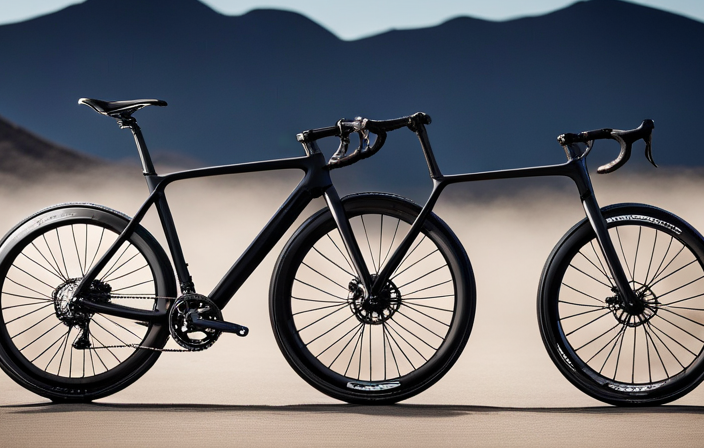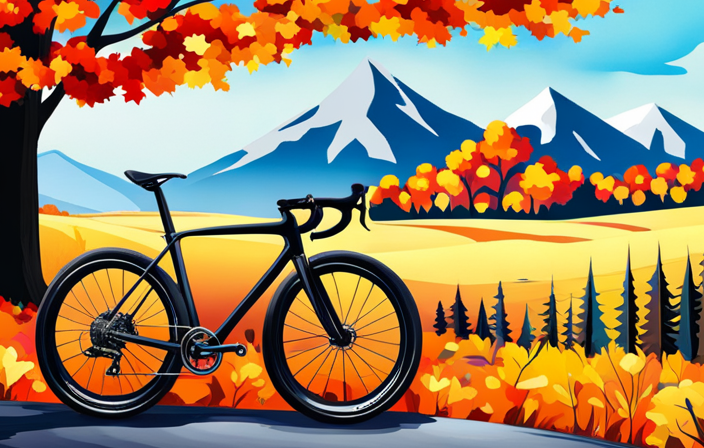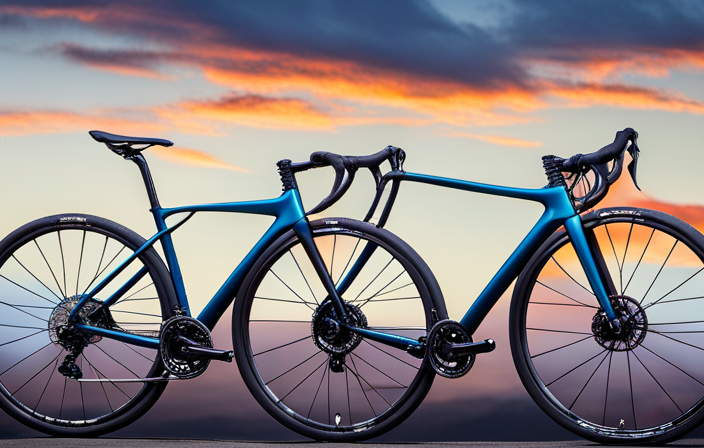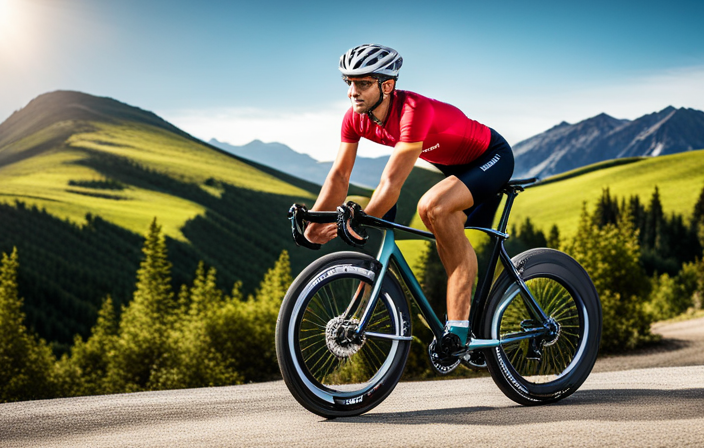What is a gravel bike, exactly? Ever pondered how it differs from various other bicycles? In this article, we’ll explore the background and inception of gravel bikes, taking a closer look at their parts and characteristics.
We’ll also discuss the benefits of riding a gravel bike, how to choose the right one for you, and essential gear and accessories to enhance your experience. Additionally, we’ll compare gravel bikes to road and mountain bikes, explore their suitability for commuting, and provide a maintenance checklist.
Join me as we unlock the world of gravel biking!
Key Takeaways
- Gravel bikes are a type of bike designed for riding on gravel roads and off-road terrain.
- They have specific components and features such as a durable frame and geometry suitable for rough terrain.
- Gravel bikes have wider tire clearance and width compared to road bikes, allowing for better traction and stability.
- They often come with disc brakes and suspension to improve braking performance and comfort on uneven surfaces.
History and Origin of Gravel Bikes
The history and origin of gravel bikes can be traced back to the early 2000s. It was during this time that cyclists started exploring new terrains and seeking more adventurous experiences beyond traditional road cycling. Gravel bike racing emerged as a popular discipline, pushing the boundaries of what was possible on two wheels. This led to the development of specialized bicycles designed to tackle rough, unpaved roads with ease.
Gravel bikes also found favor among bikepackers, who sought lightweight yet sturdy machines capable of carrying them and their gear over long distances. These versatile bicycles were built to handle a variety of surfaces, from smooth tarmac to loose gravel and dirt tracks. With wider tires for increased stability and grip, they offered better control over unpredictable terrain.
To cater to the demands of these emerging disciplines, manufacturers started incorporating specific components and features into gravel bikes. These included disc brakes for reliable stopping power in all conditions, wider gear ranges for tackling steep inclines, and mounts for attaching racks and bags.
Transitioning into the subsequent section about ‘components and features of a gravel bike,’ it is essential to understand how these elements contribute to creating an efficient and reliable machine capable of conquering any off-road adventure without compromising performance or comfort.
Components and Features of a Gravel Bike
When it comes to gravel bikes, there are three key components and features that play a crucial role in their performance: the frame and geometry, tire clearance and width, and disc brakes and suspension.
The frame and geometry of a gravel bike are designed to provide stability, control, and comfort on various terrains.
Tire clearance and width allow for the use of wider tires which enhance traction, stability, and shock absorption.
And lastly, the presence of disc brakes and suspension ensures reliable stopping power even in muddy or wet conditions while also improving ride quality over rough surfaces.
Frame and Geometry
To understand the frame and geometry of a gravel bike, you should consider how it affects your riding experience. The frame material plays a crucial role in determining the bike’s weight, stiffness, and comfort. Common gravel bike frame materials include aluminum, carbon fiber, and steel. Each material has its own characteristics that impact the overall ride quality.
Additionally, gravel bike geometry adjustments are essential for achieving optimal performance on different terrains. A longer wheelbase provides stability and enhances control when tackling rough surfaces, while a shorter wheelbase improves maneuverability for tighter turns. Moreover, adjusting the head tube angle affects steering responsiveness and stability.
Consider how these frame materials and geometry adjustments combine to bring out the best in your gravel biking adventures. As we transition into discussing tire clearance and width in the next section, it’s important to note that all these factors work together harmoniously to create an exceptional gravel riding experience.
Tire Clearance and Width
For the best riding experience, consider how tire clearance and width impact your gravel biking adventures.
The tire clearance on a gravel bike is crucial as it determines the maximum size of tires you can use. A wider tire will provide more stability and traction on loose surfaces, while a narrower tire will increase speed on smoother terrain. Additionally, the width of the tire affects its volume and air pressure capacity.
By adjusting the tire pressure, you can fine-tune your ride to suit different conditions, such as lower pressures for better grip off-road or higher pressures for increased efficiency on paved roads. Another important consideration is the tubeless tire setup, which eliminates the need for inner tubes and allows for lower pressures without risking pinch flats.
With these factors in mind, let’s now delve into disc brakes and suspension for even greater control and comfort during your gravel biking experiences.
Disc Brakes and Suspension
Consider upgrading to disc brakes and suspension for greater control and comfort during your gravel biking adventures. When it comes to braking, disc brakes outperform rim brakes in various conditions, especially in wet or muddy terrains where they provide consistent stopping power. They are also less affected by rim wear and offer better modulation, allowing for precise speed adjustments. On the other hand, suspension can greatly enhance your riding experience on rough terrain by absorbing impacts and maintaining traction. A rigid fork is lighter and more efficient for smooth surfaces but lacks the ability to dampen vibrations. Meanwhile, a suspension fork provides better shock absorption but adds weight and reduces pedaling efficiency on smoother surfaces. So, choosing between a rigid or suspension fork depends on the type of terrain you typically ride on. Transitioning into the benefits of riding a gravel bike: Let’s explore why these features make gravel bikes an excellent choice for off-road enthusiasts.
| Disc Brakes vs Rim Brakes | Rigid Fork vs Suspension Fork |
|---|---|
| Consistent stopping power in all conditions | Absorbs impacts and maintains traction |
| Better modulation for precise speed adjustments | Dampens vibrations for a smoother ride |
| Less affected by rim wear | Adds weight and reduces pedaling efficiency on smooth surfaces |
Now let’s delve into the benefits of riding a gravel bike without delay.
Benefits of Riding a Gravel Bike
Explore the many advantages of riding a gravel bike, from its versatility on various terrains to the comfortable riding position it offers.
One of the key benefits of a gravel bike is its ability to handle different surfaces with ease. Whether you’re riding on paved roads, dirt paths, or rocky trails, a gravel bike can tackle them all. This makes it an excellent choice for those who enjoy exploring different types of terrain.
Another advantage of riding a gravel bike is the opportunity for training and improving your cycling skills. Gravel riding requires a combination of endurance, strength, and technical abilities. By regularly riding a gravel bike, you can work on these aspects and enhance your overall performance as a cyclist.
In addition to its versatility and training potential, gravel bikes also provide a more comfortable riding experience compared to other types of bikes. The frame geometry and wider tires absorb vibrations and bumps from rough surfaces, resulting in less fatigue and discomfort during long rides.
Now that we’ve discussed the benefits of riding a gravel bike, let’s move on to how you can choose the right one for yourself.
How to Choose the Right Gravel Bike for You
When choosing the right gravel bike for you, it’s important to take into account your riding preferences and goals. Gravel bike sizing is crucial to ensure a comfortable and efficient ride. To determine the correct size, consider factors such as your height, inseam length, and reach. A well-fitting gravel bike will provide optimal power transfer and control.
To help you make an informed decision, here is a table comparing different gravel bikes based on their key features:
| Feature | Bike A | Bike B | Bike C | Bike D |
|---|---|---|---|---|
| Frame Material | Aluminum | Carbon Fiber | Steel | Titanium |
| Tire Clearance (mm) | 40 | 45 | 50 | 35 |
| Weight (lbs) | 22 | 19 | 24 | 23 |
| Brake Type |
Disc Hydraulic Disc Disc Mechanical Disc |Along with finding the right size, considering gravel bike accessories can enhance your riding experience. Some essential accessories include a helmet for safety, lights for visibility during low-light conditions, fenders to protect from mud splatter, and a saddlebag for carrying tools and supplies.
In conclusion, choosing the right gravel bike involves assessing your sizing needs and considering various features of different models. Once you have selected your ideal gravel bike, it’s time to explore essential gear and accessories that will further enhance your adventures on the trails.
Essential Gear and Accessories for Gravel Biking
After carefully selecting the perfect gravel bike that suits your riding style and preferences, it’s time to dive into the world of essential gear and accessories for gravel biking. These items are crucial in providing comfort, safety, and convenience during your rides.
When it comes to gravel bike gear, a well-fitting helmet is an absolute must to protect your head in case of any unforeseen accidents. Additionally, padded cycling shorts with chamois will help reduce discomfort on longer rides by providing extra cushioning for your sit bones.
To enhance visibility and safety, consider investing in bright-colored or reflective clothing, as well as front and rear lights for low-light conditions. Since gravel biking often takes you off-road into rugged terrains, having a reliable set of puncture-resistant tires can save you from unnecessary headaches.
In terms of accessories, a hydration pack or water bottle cage is essential to keep yourself hydrated throughout the ride. A multi-tool kit with tire levers will come in handy for quick repairs or adjustments on the go. Don’t forget to attach a saddlebag or frame bag to store spare tubes, CO2 cartridges, and other small necessities.
With all this gear at hand, you’ll be fully equipped to tackle any gravel adventure that comes your way. So let’s shift gears now and delve into the next aspect of preparing for exhilarating rides – training and preparation for gravel riding.
Training and Preparation for Gravel Riding
When it comes to training and preparation for gravel riding, there are three key points that I find crucial.
First, building endurance and strength is essential for tackling long rides on rough terrain. Incorporating a mix of cardiovascular workouts and strength training exercises into your routine is important. This will help you handle the physical demands of gravel riding.
Second, navigation and route planning are crucial to staying on track during your rides, especially in unfamiliar areas. Knowing how to navigate and plan routes will ensure that you don’t get lost and can make the most of your riding time.
Third, proper maintenance and bike care are crucial for keeping your gravel bike in top shape. The rough conditions can take a toll on its components, so regular cleaning, lubrication, and inspection of the bike’s various parts are necessary. This will help prevent breakdowns and keep your bike performing at its best.
By focusing on these three areas – building endurance and strength, navigation and route planning, and maintenance and bike care – you’ll be well-prepared for gravel riding and able to enjoy the experience to the fullest.
Building Endurance and Strength
Building endurance and strength is essential for improving performance on a gravel bike. As a gravel rider, I understand the importance of training my body to handle long distances and challenging terrains. To build endurance, I focus on incorporating longer rides into my training regimen, gradually increasing mileage over time. Additionally, I include interval training sessions to push my limits and improve cardiovascular fitness. Strengthening exercises such as squats, lunges, and core workouts help me maintain stability and power on rough terrain.
To supplement my training, I pay close attention to nutrition and hydration strategies. Proper fueling before, during, and after rides is crucial for sustained energy levels and recovery. I ensure that my bikepacking essentials include sufficient water storage capacity and electrolyte-rich hydration options.
Transitioning into navigation and route planning requires careful consideration of terrain difficulty, distance covered, and potential challenges along the way. By honing both physical abilities and navigational skills, I am better equipped to tackle any gravel riding adventure with confidence.
Navigation and Route Planning
To navigate and plan your route effectively, it’s important to consider the difficulty of the terrain, the distance you will cover, and any potential challenges you may encounter along the way. Route optimization plays a crucial role in ensuring a smooth gravel biking experience.
By utilizing GPS technology, you can easily map out your desired route and analyze various factors such as elevation gain, road conditions, and possible obstacles. This allows for efficient planning while maximizing enjoyment on your gravel bike adventure. Additionally, GPS technology enables real-time tracking of your progress, helping you stay on course and make necessary adjustments if needed.
Whether you prefer pre-planned routes or exploring new paths, incorporating advanced navigation tools into your gravel biking routine ensures a seamless journey from start to finish.
Transitioning into the subsequent section about ‘maintenance and bike care tips,’ it’s essential to keep your gravel bike in optimal condition to enhance performance and longevity.
Maintenance and Bike Care Tips
Proper maintenance and care are essential for keeping your gravel bike performing at its best. Regular bike cleaning is crucial to remove dirt, mud, and grime that can accumulate during rides.
Start by washing your bike with a mild soap or bike-specific cleaner, using a soft brush to scrub hard-to-reach areas. Rinse thoroughly and dry with a clean cloth to prevent moisture damage.
Chain lubrication is another critical aspect of maintenance. Apply lubricant to the chain, ensuring each link is coated evenly. Wipe off any excess oil to prevent attracting dirt and debris.
Remember to check tire pressure regularly and inspect for any signs of wear or damage.
By properly maintaining your gravel bike, you’ll ensure it stays in top condition for upcoming gravel bike events and races without missing a beat.
Gravel Bike Events and Races
Don’t miss out on the exciting gravel bike events and races happening near you. Gravel bike events are a fantastic way to challenge yourself and connect with other riders who share your passion for off-road cycling. These events range from casual group rides to competitive races, offering something for riders of all skill levels.
Gravel bike races are gaining popularity in the cycling community due to their unique blend of endurance, technical skill, and adventure. These races take place on a variety of terrain, including dirt roads, gravel paths, and even singletrack trails. Participants can expect to encounter challenging climbs, fast descents, and unpredictable weather conditions.
One notable gravel bike event is the Dirty Kanza, held annually in Kansas. This race covers a grueling 200 miles of rugged Flint Hills terrain and attracts participants from around the world. Another popular event is the Belgian Waffle Ride in California, known for its challenging course that combines road racing with off-road sections.
These gravel bike events offer an exciting opportunity to push your limits and discover new routes in beautiful natural settings. So lace up your shoes, hop on your gravel bike, and get ready for an unforgettable adventure through inspiring gravel bike destinations.
Inspiring Gravel Bike Destinations
When it comes to gravel biking, there are few things as exhilarating as exploring scenic routes and trails. From winding through picturesque forests to traversing stunning mountain landscapes, these paths offer breathtaking views and a sense of adventure.
Additionally, gravel bike-friendly locations provide the perfect opportunity to immerse oneself in the sport, with well-maintained trails and ample resources for riders.
For those seeking an even greater experience, international gravel bike tours offer the chance to explore new cultures while experiencing some of the most challenging and awe-inspiring terrains around the world.
Scenic Routes and Trails
Explore scenic routes and trails on a gravel bike, and you’ll discover breathtaking views along the way. Whether you’re embarking on bikepacking adventures or simply looking for a picturesque ride, gravel biking offers unparalleled opportunities to immerse yourself in nature’s beauty. Take a look at the table below to get an idea of some of the most stunning routes and trails that are perfect for gravel biking:
| Scenic Routes | Description |
|---|---|
| Coastal Cliffs | Ride along rugged coastal cliffs, with crashing waves below and panoramic ocean views. |
| Mountain Passes | Conquer challenging mountain passes, surrounded by majestic peaks and lush forests. |
| Countryside Charm | Pedal through quaint countryside landscapes, dotted with charming farms and rolling hills. |
These scenic routes provide unforgettable experiences for gravel bikers seeking adventure and natural splendor. Now let’s dive into the next section about gravel bike-friendly locations without missing a beat.
Gravel Bike-Friendly Locations
After exploring the breathtaking scenic routes and trails that are perfect for gravel biking, it’s time to delve into the world of gravel bike-friendly locations. These are places where you can not only ride your gravel bike, but also enjoy some well-deserved relaxation and refueling.
One of my favorite aspects of gravel biking is discovering hidden cafes nestled along the routes, offering a warm welcome and delicious treats to fuel my adventures. These gravel bike friendly cafes provide the perfect pit stop to replenish energy levels before tackling more miles on the trail.
In addition to these cozy cafes, there is a thriving community of gravel bike enthusiasts who come together for exhilarating races. From local events to national competitions, these races showcase the true spirit and camaraderie of the gravel biking community. Whether you’re a seasoned competitor or just starting out, participating in these races is an incredible way to challenge yourself and connect with like-minded individuals.
Now that we’ve explored some of the best locations for gravel biking and discovered welcoming cafes along the way, let’s take our exploration to an international level as we delve into thrilling gravel bike tours across different countries.
International Gravel Bike Tours
One exciting way to expand your gravel biking adventures is by embarking on international tours. These tours offer the opportunity to explore new landscapes, cultures, and terrain while participating in thrilling international gravel bike races or enjoying scenic gravel bikepacking adventures. To give you an idea of some popular international locations for these types of tours, here is a table highlighting three options:
| Location | Race Options | Bikepacking Routes |
|---|---|---|
| Tuscany, Italy | Strade Bianche | Via Francigena |
| Iceland | The Rift | Laugavegur Trail |
| New Zealand | The Pioneer | Old Ghost Road |
By joining one of these international gravel bike tours, you can challenge yourself in prestigious races or soak up the breathtaking scenery on epic bikepacking routes. It’s important to remember that safety is paramount when engaging in gravel riding activities. Transitioning into the next section about safety tips and precautions for gravel riding…
Safety Tips and Precautions for Gravel Riding
To ensure your safety while gravel riding, remember to always wear a helmet and use reflective gear to increase visibility. Safety gear is essential when it comes to gravel riding, as the terrain can be unpredictable and accidents are more likely to occur. In addition to a helmet, consider wearing knee and elbow pads for added protection. Reflective gear such as vests or ankle bands will help make you more visible to other riders, especially in low-light conditions.
When it comes to riding techniques, there are a few key things to keep in mind. First, maintain a steady and controlled speed while navigating through gravel. Sudden acceleration or braking can cause your tires to lose traction and result in a loss of control. It’s also important to keep both hands on the handlebars at all times for optimal stability.
Incorporating keywords like ‘safety gear’ and ‘riding techniques,’ these tips will help you stay safe during your gravel rides. However, accidents can still happen even with proper precautions. Therefore, it’s crucial that you know how to perform basic maintenance and repairs on your gravel bike. This knowledge will allow you to address any issues that may arise during your rides and ensure the longevity of your bike.
Transitioning into the subsequent section about ‘maintenance and repair for gravel bikes,’ let’s explore some essential tips that every rider should know.
Maintenance and Repair for Gravel Bikes
Make sure you regularly check and clean your gravel bike to ensure it stays in optimal condition for your rides. Proper bike cleaning is essential to prevent the buildup of dirt, grime, and debris that can affect the performance of your bike.
Here are some key steps to follow when maintaining and repairing your gravel bike:
-
Clean the frame: Start by gently washing the frame with a mild soap or bike-specific cleaner. Pay close attention to hard-to-reach areas such as bottom brackets and seat stays.
-
Lubricate moving parts: Apply lubrication to the chain, derailleurs, and other moving parts regularly to minimize wear and ensure smooth operation.
-
Check tire pressure: Maintain proper tire pressure for better traction and reduced risk of flats. Inspect tires for any signs of damage or excessive wear.
-
Inspect brake pads: Regularly inspect brake pads for wear and replace them if necessary. Ensure proper alignment with the rims or discs for optimal braking performance.
-
Troubleshoot common issues: Be familiar with common problems like shifting difficulties, squeaky brakes, or loose bolts. Refer to online resources or seek professional help if needed.
By taking these maintenance steps seriously, you can keep your gravel bike running smoothly and avoid unnecessary breakdowns during your rides.
Transitioning into the next section about gravel bike communities and online resources allows riders to connect with others who share similar interests in maintaining their bikes effectively.
Gravel Bike Communities and Online Resources
Joining gravel biking communities and accessing online resources can help you connect with fellow enthusiasts and find valuable information to enhance your riding experience. One way to immerse yourself in the gravel bike community is by attending gravel bike community events. These events bring together riders of all skill levels, allowing you to meet new people, learn from experienced riders, and discover new routes and trails.
In addition to community events, online forums and groups are a great resource for gravel bike riders. These platforms provide a space for riders to ask questions, share tips and tricks, and discuss their experiences with fellow enthusiasts. Whether you’re looking for advice on bike maintenance, trail recommendations, or just want to share your latest ride, these online communities have it all.
Furthermore, online resources such as blogs, websites, and social media accounts dedicated to gravel biking offer a wealth of information. From gear reviews and product recommendations to training plans and route suggestions, these resources can help you stay up-to-date with the latest trends in the gravel biking world.
By immersing yourself in the gravel bike community through events and online platforms, you’ll gain valuable insights that will enhance your riding experience. Now let’s explore the key differences between a gravel bike, road bike, and mountain bike…
Gravel Bike vs. Road Bike vs. Mountain Bike
When choosing between a gravel bike, road bike, and mountain bike, you’ll need to consider the terrain you plan on riding on and your preferred riding style.
A gravel bike is designed for off-road adventures and long-distance riding on rough surfaces like gravel roads, dirt paths, or even singletrack trails. It is similar to a cyclocross bike but with more relaxed geometry, wider tires, and additional clearance for mud. The benefits of gravel riding extend beyond just fitness; it also provides mental health benefits by allowing riders to explore new places and escape the hustle and bustle of city life.
Compared to a road bike, which is built for speed on smooth pavement, a gravel bike offers greater versatility and comfort over varied terrains. The wider tires provide better traction and stability on uneven surfaces while also absorbing vibrations from rough roads.
On the other hand, a mountain bike is specifically designed for off-road trail riding with features like suspension forks and aggressive treaded tires.
Transitioning into the next section about ‘gravel bikes for commuting and everyday use,’ it’s important to note that their versatility makes them an excellent choice not only for adventurous rides but also as practical transportation options in urban areas or as reliable daily commuters.
Gravel Bike for Commuting and Everyday Use
If you’re looking for a versatile option that can handle both your daily commute and weekend adventures, a gravel bike might be the perfect choice. Gravel bikes are designed to tackle various terrains, from paved roads to rough gravel paths.
When it comes to commuting and everyday use, there are a few factors to consider. Firstly, gravel bike sizing is crucial for optimal comfort and efficiency. It’s important to find the right frame size that suits your body proportions. A proper fit ensures better control and reduces the risk of discomfort or injuries during long rides.
Additionally, there are numerous gravel bike accessories available that can enhance your commuting experience. Fenders help keep you dry on wet roads, while racks and panniers provide convenient storage options for carrying your work essentials or groceries.
Transitioning into the subsequent section about ‘gravel bike maintenance checklist,’ it’s essential to note that regular maintenance is key in keeping your gravel bike in top shape. From checking tire pressure and cleaning the drivetrain to inspecting brake pads and tightening bolts, following a comprehensive maintenance routine will ensure smooth rides every time.
Now let’s move on to discussing the necessary steps for maintaining your gravel bike properly.
Gravel Bike Maintenance Checklist
To properly maintain your gravel bike, it’s important to follow a comprehensive checklist that includes tasks such as checking tire pressure and cleaning the drivetrain. These routine maintenance procedures will not only prolong the lifespan of your bike but also ensure optimal performance on every ride.
One crucial aspect of gravel bike maintenance is keeping it clean. After each ride, make sure to remove any dirt, mud, or debris from the frame, wheels, and components. This can be done using a soft brush or sponge and mild soapy water. Pay particular attention to the drivetrain as it tends to accumulate grime quickly. Regularly cleaning the chain is essential for smooth shifting and efficient power transfer.
In addition to cleaning, regularly inspecting and lubricating the chain is vital for maintaining its longevity. A well-lubricated chain will reduce friction and prevent wear on both the chain itself and other drivetrain components.
To help you stay organized with your gravel bike maintenance routine, here’s a handy checklist:
| Maintenance Task | Frequency | Tools Needed |
|---|---|---|
| Check tire pressure | Before every ride | Tire pressure gauge |
| Clean frame | After every ride | Soft brush/sponge |
| Lubricate chain | Every 100 miles | Chain lube |
By following this checklist diligently, you can ensure that your gravel bike remains in top condition for many adventures to come. Now let’s explore what lies ahead for the future of gravel biking and trends in this exciting sport.
Future of Gravel Biking and Trends
The future of gravel biking promises exciting advancements in the industry, with a significant growth projected for the gravel bike market. Technological advancements continue to push the boundaries of what these bikes can do, making them even more versatile and capable on various terrains.
Additionally, there is an increasing focus on environmental and sustainable practices within the gravel riding community. Riders are becoming more conscious of their impact on nature and seeking ways to minimize it through responsible riding practices and eco-friendly gear choices.
Growth of Gravel Bike Industry
The gravel bike industry has experienced significant growth in recent years. The rise in popularity of gravel biking has presented both challenges and opportunities for the industry.
As more cyclists discover the joys of riding off-road on mixed terrain, the demand for gravel bikes has skyrocketed. This increased demand has led to a surge in production and sales, with manufacturers scrambling to meet the needs of avid gravel riders.
The impact of gravel biking on the cycling industry as a whole cannot be ignored. It has breathed new life into an already thriving market, attracting a new segment of riders who crave adventure and versatility.
With this growth comes exciting possibilities for technological advancements in gravel bikes, which I will delve into further in the next section about ‘technological advancements in gravel bikes’.
Technological Advancements in Gravel Bikes
Get ready to explore new horizons with the latest advancements in technology for your off-road adventures.
The gravel bike industry has seen significant growth in recent years, and with it comes exciting developments in bike technology. Manufacturers are constantly pushing the boundaries to provide riders with superior performance and comfort on rough terrains.
One of the key areas of focus is gravel bike accessories, which enhance the overall riding experience. From advanced suspension systems that absorb shocks to tubeless tires that reduce the risk of punctures, these accessories make a real difference when tackling challenging trails. Additionally, there have been improvements in drivetrain efficiency and braking systems specifically designed for gravel bikes. These technological advancements ensure that riders can confidently navigate any terrain with ease and precision.
Transitioning into the subsequent section about environmental and sustainable practices in gravel riding, it is essential to consider not only technological advancements but also our impact on nature while enjoying this thrilling sport.
Environmental and Sustainable Practices in Gravel Riding
As we continue exploring the technological advancements in gravel bikes, it is important to consider their environmental impact and how riders can make sustainable gear choices.
Gravel riding takes us off-road, allowing us to connect with nature and experience the beauty of untouched landscapes. However, this freedom comes with a responsibility to minimize our ecological footprint.
When it comes to gear choices, opting for environmentally friendly materials such as recycled or biodegradable components can significantly reduce waste. Additionally, selecting durable and long-lasting equipment ensures that we don’t contribute to the disposable culture prevalent in modern society.
It’s also crucial to practice Leave No Trace principles while on the trail, respecting wildlife habitats and leaving them undisturbed.
By making conscious decisions regarding our gear and actions on the trail, we can enjoy gravel riding while preserving our natural surroundings for future generations.
Frequently Asked Questions
Are gravel bikes suitable for long-distance rides?
Yes, gravel bikes are absolutely suitable for long-distance rides. In fact, they excel in endurance cycling!
With their sturdy construction and versatile design, gravel bikes can handle various terrains and road conditions effortlessly. They offer a more relaxed riding position for comfort during those extended hours on the saddle.
The wider tires provide better traction and stability, making it easier to tackle rough surfaces. These features, combined with long distance cycling tips, make gravel bikes an ideal choice for endurance rides.
Can gravel bikes be used for mountain biking?
Gravel bikes are not ideal for mountain biking due to their limited off-road capabilities compared to dedicated mountain bikes.
While gravel bikes can handle some light off-roading, they lack the suspension and aggressive tire tread needed for more challenging terrain.
Mountain bikes, on the other hand, are specifically designed for off-road riding with features such as full suspension systems and wider tires with knobby treads to provide better traction and control on rough trails.
How do gravel bikes handle on different types of terrain?
Gravel bikes are versatile machines that handle different terrains with ease. Although some may argue that road bikes are better for off-road adventures, gravel bikes excel in their ability to handle various surfaces.
With wider tires and a more relaxed geometry, they offer stability and comfort on rough terrain. Suspension can greatly enhance gravel bike performance on rough terrain by absorbing shocks and maintaining traction.
Gravel bikes truly provide an exceptional riding experience across different types of terrain.
What type of tires are recommended for gravel biking?
When it comes to gravel biking, there are two main types of tires to consider: tubeless and clincher.
Tubeless tires provide better puncture resistance and allow for lower tire pressure, resulting in improved traction on rough terrain. However, they require a bit more maintenance and can be more difficult to install.
On the other hand, clincher tires are easier to install and generally more affordable.
As for tire pressure, finding the right balance is crucial. Too low pressure can cause pinch flats, while too high pressure may result in a harsh ride. Experimentation is key to finding the optimal tire pressure for your specific bike and riding style.
Are gravel bikes suitable for beginners?
Gravel bikes can be suitable for beginners who want to explore road cycling with versatility.
One advantage is their ability to handle various terrains, providing a smooth and comfortable ride on both paved roads and gravel paths.
However, due to their wider tires and heavier frames, they might be slightly slower on paved roads compared to traditional road bikes.
For beginners, it’s important to choose a gravel bike with a comfortable geometry, reliable components, and appropriate tire width for a balanced riding experience.
Conclusion
In conclusion, gravel biking is a thrilling and versatile cycling discipline that offers a unique experience for riders. With its origins in the early days of off-road cycling, gravel bikes have evolved to become specialized machines designed for tackling rough terrain with ease.
The components and features of these bikes make them ideal for long-distance rides, bikepacking adventures, and even everyday commuting. When choosing a gravel bike, it’s important to consider factors such as frame material, tire clearance, and gearing options. Equipping yourself with the right gear and accessories will enhance your gravel biking experience and keep you prepared for any situation on the road.
Gravel biking can be likened to exploring uncharted territory; it’s like embarking on an expedition through rugged landscapes, where every turn presents new challenges and breathtaking sights. As this sport continues to gain popularity among cyclists of all levels, we can expect exciting advancements in technology and design that will shape the future of gravel biking.
So grab your gravel bike, hit the trails or unpaved roads, and discover a whole new world of cycling possibilities!









